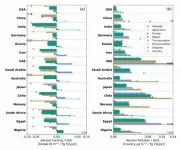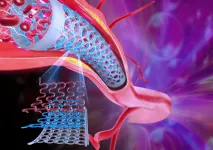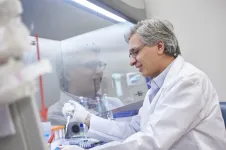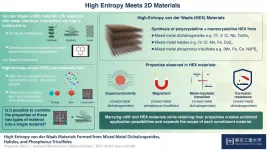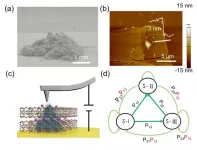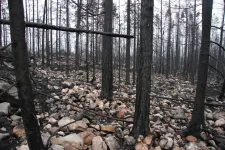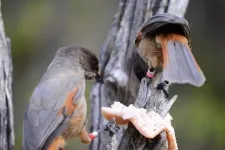(Press-News.org) Aerosol reductions that would take place as countries meet climate goals could contribute to global cooling and prevent more than one million annual premature deaths over a decade, according to a new study from the University of California San Diego.
The landmark Paris Agreement of 2016 does not address emissions of aerosols--fine particulates like soot that cause pollution. Nonetheless, findings from the recent study authored by researchers at UC San Diego's Scripps Institution of Oceanography and the School of Global Policy and Strategy suggests that aerosol accounting should be explicitly incorporated into international climate policy.
It is crucial because as countries implement their greenhouse gas reduction targets under the Paris climate agreement, their choices about which sectors to target will also reduce aerosols that are co-emitted, which will have major impacts to public health and global temperatures.
"Joint consideration of greenhouse gases and aerosols is critical," said Pascal Polonik, a Ph.D. student at Scripps Oceanography and first author of the paper published in Earth's Future. "Polluting particles, known as aerosols, are emitted in tandem with greenhouse gases but aren't accounted for. While all greenhouse gas emissions might be thought of as unambiguously harmful, aerosols are more complicated. All aerosols are harmful to human health but they also often help counteract global warming by cooling the Earth's surface."
It is estimated that emissions of aerosols from burning fossil fuels like coal and diesel are responsible for nine million premature deaths worldwide. Though most aerosols have a cooling effect because they reflect sunlight, certain types, such as black carbon have a warming effect.
The UC San Diego team wanted to explore the tradeoffs countries would face by taking aerosols into consideration while concurrently making CO2 cuts to implement Paris pledges.
Their model provides a country-by-country breakdown of the impacts of aerosol reductions across the eight economic sectors which cause emissions. For each country, the authors consider three scenarios. The first scenario prioritizes air quality, targeting aerosol cuts to the "dirtiest" sectors that emit the most solid particles. The second prioritizes temperatures by targeting industries that emit aerosols that most contribute to warming and the third, dubbed the "politically expedient" approach, reduces emissions from all economic sectors equally.
Preventing as many as one million premature deaths per year by cutting emissions from certain sectors first
Under these three approaches, the authors find that by 2030, the three scenarios would yield prevention of as many as one million premature deaths every year and global temperature differences of the same magnitude as those from greenhouse gas reductions.
The study demonstrates the importance of domestic decisions for reducing emissions because making cuts to certain sectors can produce cleaner air and save more lives, or further reduce warming.
For example, the U.S. could choose to save more lives by targeting aerosol emissions in the industrial production, shipping, or residential/commercial sectors. It could also choose to limit warming more with cuts to the solvents, residential/commercial and waste sectors.
To the authors' surprise, the third scenario, which may be most politically feasible to implement as policy, can lead to both more deaths and less cooling in certain places, such as Africa, China, the Middle East and South America.
"Implementing cuts equally and making each industry do their fair share may be the easiest way to implement climate policy in a democratic society like the U.S. where there are many competing political interests," said co-author Kate Ricke, assistant professor with Scripps Oceanography and the School of Global Policy and Strategy. "However, there are real benefits to being thoughtful about how aerosols factor into climate policy outcomes. There may be big benefits to cutting emissions from certain sectors first."
The research is critical to the U.S., as it is currently renegotiating its Paris agreement climate pledge.
"Our analysis does indicate some considerable tradeoffs between temperature and health outcomes that will need to be contended with in meeting near-term emission reductions goals," said Jennifer Burney, the Marshall Saunders Chancellor's Endowed Chair in Global Climate Policy and Research at the School of Global Policy and Strategy.
In India, for example, emission cuts in the transportation sector could save more lives, while cuts in the residential sector would produce more cooling.
The authors note that because the tradeoffs vary considerably for each region, countries are likely to have different priorities for weighing reduction of warming versus protection of public health when making climate policy decisions.
The conclusion, they emphasize, is that there are many ways to achieve the same magnitude of greenhouse gas reduction pledged in the Paris Agreement, but the aerosol emissions that "ride along" with those cuts may vary a lot depending on which sectors are targeted. As such, the authors write, "we believe that this is a strong case for explicitly considering aerosols when constructing climate policy."
INFORMATION:
BOSTON - For patients who have experienced certain common types of stroke, a small chip inserted under the skin may help physicians predict their likelihood of experiencing a second stroke, and therefore their likelihood of benefiting from preventive therapy. The findings come from a recent clinical trial published in the END ...
From the biggest bridges to the smallest medical implants, sensors are everywhere, and for good reason: The ability to sense and monitor changes before they become problems can be both cost-saving and life-saving.
To better address these potential threats, the Intelligent Structural Monitoring and Response Testing (iSMaRT) Lab at the University of Pittsburgh Swanson School of Engineering has designed a new class of materials that are both sensing mediums and nanogenerators, and are poised to revolutionize the multifunctional material technology big and small.
The research, recently published in Nano Energy, describes a new metamaterial system that ...
Philadelphia, June 1, 2021--Researchers at Children's Hospital of Philadelphia (CHOP) have developed a proof-of-concept treatment for blood disorders like sickle cell disease and beta-thalassemia that could raise hemoglobin levels by activating production of both fetal and adult hemoglobin. Using a viral vector engineered to reactivate fetal hemoglobin production, suppress mutant hemoglobin, and supply functional adult hemoglobin, the researchers developed an approach that could produce more hemoglobin through a single vector. The results were published in Haematologica.
"Until now, researchers have been exploring one of two approaches to treating blood disorders ...
The discovery of graphene, a 2D layered form of carbon, once caused a paradigm shift in science and technology like no other. As this wonder material drew attention from material scientists around the world, it spurred research on other materials that were structurally similar, such as "van der Waals materials", which comprise strongly-bonded 2D atomic layers that are held together by weak interlayer interactions called "van der Waals forces". These materials quickly caught on because they were highly conducive to structural modifications, such as stacking, twisting, and insertion of foreign molecules between layers, which gave them interesting physical properties ...
Getting enough sleep can be a real challenge for shift workers affecting their overall health. But what role does being an early bird or night owl play in getting good rest? Researchers from McGill University find a link between chronotype and amount of sleep shift workers can get with their irregular schedules.
"Some people seem to be hardwired to sleep early, while others tend to sleep late. This preference, called chronotype, is modulated by our circadian system - each person's unique internal timekeeper," says lead author Diane B. Boivin, a Professor in the Department of Psychiatry at McGill University.
Their study published in Sleep is the first to examine the relationship between ...
Algorism plays a significant role in predicting future states of a system. Particularly, non-Markov chain algorithm has been widely applied in epidemic spreading processes, social and man-made memory networks, the environment-related quantum entangled states, and artificial algorisms such as face pose tracking. Traditionally, a large number of memories and computing cells are integrated to achieve these goals by software algorisms, showing high complexity. In the paper published in Science Bulletin, a group led by Bilu Liu and Hui-Ming Cheng from Tsinghua-Berkeley Shenzhen Institute (TBSI) of Tsinghua University has realized a non-Markov chain algorithm in a single resistive random access memory (RRAM) based on 2D mineral material ...
Swedish researchers from institutions including Uppsala University have spent four years gathering data from the areas affected by the major forest fire of 2014. In their study of how the ecosystem as a whole has been altered, they could see that water quality in watercourses quickly returned to normal, while forested areas continued to lose carbon for many years after the fire.
The consequences of major forest fires remain poorly studied in Northern Europe. To improve this situation, researchers from Uppsala University, the Swedish University of Agricultural Sciences (SLU) and the Swedish Meteorological ...
Siberian jays are group living birds within the corvid family that employ a wide repertoire of calls to warn each other of predators. Sporadically, however, birds use one of these calls to trick their neighbouring conspecifics and gain access to their food. Researchers from the universities of Konstanz (Germany), Wageningen (Netherlands), and Zurich (Switzerland) have now examined how Siberian jays avoid being deceived by their neighbours. The study, published in the journal Science Advances, shows that these birds have great trust in the warning calls from members of their own group, but mainly ignore such ...
News media reports about scientific failures that do not recognize the self-correcting nature of science can damage public perceptions of trust and confidence in scientific work, according to findings by researchers at the Annenberg Public Policy Center (APPC) of the University of Pennsylvania and the University at Buffalo, the State University of New York.
News stories about science follow several specific narratives, the researchers write in a new study in the journal Public Understanding of Science. One is that science is "in crisis" or "broken," a narrative driven in recent years by reports of unsuccessful efforts to replicate findings in ...
A new miniature 3D model of human bone marrow has been described today in the open-access eLife journal.
The model may help clinicians predict which patients will benefit from a new therapy for blood platelet disorders, such as Inherited Thrombocytopenias - a group of familial disorders that inhibit the production of platelets. It could also enable further study of these disorders and give scientists a new tool to test experimental treatments.
Platelets are cells that are necessary for the blood to clot and stop bleeding. Having too few platelets can lead to internal or serious bleeding after surgery or injuries, which is usually treated with therapies that cause clotting. Recent studies have shown that a drug called Eltrombopag increases ...
